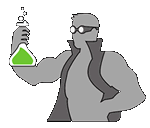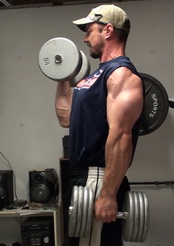This method takes the concept of a "drop set" and applies it to range of motion instead of weight changes.
We're going to target a MAXIMUM range of motion with this method, which is going to put incredible workload on your entire posterior chain.
I get that this one LOOKS scary...
This is definitely an ADVANCED technique, due to the position that it puts your body in and the amount of overload it puts on the spinal erector muscles.
Only try this one if you feel that your core and other spinal stabilizing muscles are strong enough to handle the loading.
And just to be clear, this will NOT hurt your back, as long as you're physically capable of doing it with good form, i.e. your core is strong enough to brace the lower back and maintain good spinal position, and you keep to moderate weights.
If that's not the case, or if you feel nervous about doing this one at all, don't do this one.
I also recommend using grip assistance for this (straps or hooks) so your grip isn't a limiting factor.
Deficit Deadlifting Taken to the Limit
To perform this method, I recommend using rubberized bumper plates. These won't slip when stacked and should fit inside the frame of the trap bar that you stand inside. You can use a small, squat Step platform for these as well, if you have that available to you.
You'll also need a trap bar.
I've got 5 bumper plates stacked up high enough so that the high handles of my trap bar are about an inch or so below the level of my feet.
*** That is MY maximum range of motion. You may decide you don't want to go quite that low, which is totally fine. ***
I've got 275 lbs on the bar.
To determine how much weight I could use for this, I started very light (135 lbs) then gradually worked up in weight until I found a weight where I could get 3 reps (while keeping good core bracing and back position) and a fourth would be really tough. This is probably about 50% of my 1 RM on the normal-range exercise.
I HIGHLY recommend you do the same, if you want to give it a try...start very light and get a feel for the exercise and the range of motion. It's a great method, but you need to be methodical with this one.
Step up onto the stacked plates then reach down and grab the handles.
Drop your butt down in an ATG squat. This is NOT the start position of the exercise, though...don't start putting loading on the back yet.

Now bring your butt up and lean forward so that your chest is on your thighs. Make sure your core is braced solidly.
Even in this position, you can see I've got a slight arch in my lower back. This is the actual start position.
NOW start the deadlift.

Stand up to full lockout.

Lower the bar back down to the floor and reset your body position, completely releasing the load at the bottom so that you can reset to optimal body position.
Do 3 reps at that height. DO NOT go to failure on any of these mini-sets.
Now take a plate off the top.

And repeat the set for 3-4 more reps.


Take another plate off the top.

And go again.


Take another plate off and repeat.



Keep going...



Remove the final plate and do a normal Trap Bar Deadlift.


This next part is optional...but still VERY effective.
Now that you've done the deficit to floor range of motion drop set, you can continue shortening the range of motion into the partial range.
Roll the bar forward, put a plate underneath where the bar plates will be then set the bar up on those plates. This will decrease the range of motion a little more.

Do it one more time.

Lift one end of the bar up and set it on the plates, then the other end.



By the time I finished this entire sequence (it took a little more than 5 minutes to complete), my spinal erectors were FRIED, my upper back was toast and my core was finished. Only one set of this method is necessary.
And I had ZERO lower back pain as a result of doing this one (in fact, it felt great even days after), because I used a moderate weight and was very careful to brace my core strongly on each reps (I didn't use a belt).
Again, because this is a much greater than normal range of motion, targeting and strengtheing the posterior chain in a way that almost no other type of training will, this should be done ONLY by advanced trainers.
---
Are you 40...50...60 or even 70+ years old and want to build muscle and strength like you did 20 years ago?
If you feel like you're fighting a losing battle, you're ready to discover the REAL secret to REVERSING muscle loss due to aging...
*** You need to train the body systems that SUPPORT your muscle mass, not just the muscle itself. ***
These underlying support systems diminish as you age, which is why you lose muscle as you get older no matter how hard you train... but with strategic training, these systems can be regenerated.
Share This Page...
Want More Strength-Building Techniques and Programs?
You'll find them here...



